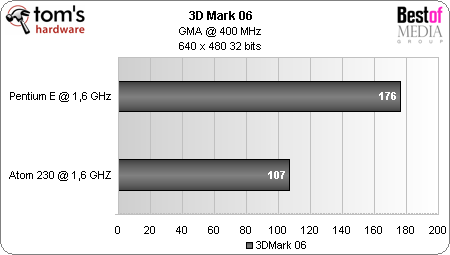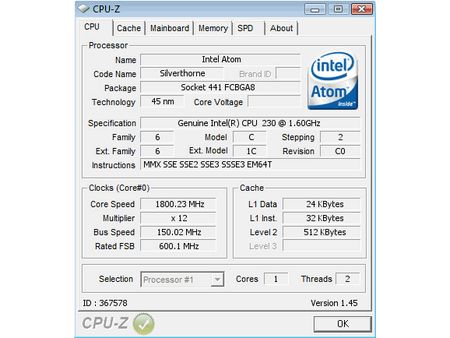Intel Atom CPU Review
Overclocking and 3D
Finally, we ran tests in two areas that won’t necessarily be of interest with an Atom platform, but that will appeal to some of you – 3D and overclocking.
3DMark with the GMA
Since our motherboard had no PCI-Express or AGP slot (and since PCI graphics cards are getting scarce), we limited ourselves to the GMA 950. To compare it, we used the Gigabyte motherboard, equipped with the same chipset, with the Pentium E 2160 clocked to 1.6 GHz to match the Atom. So the two machines were using an identical IGP (GMA 950 @ 400 MHz) and a CPU at the same frequency (1.6 GHz). Both computers were fitted with a single DDR2-667 DIMM.

As you can see, with 3DMark 06, in 640 x 480 without filters, performance was weak... and above all, that the Pentium E remains noticeably faster than the Atom, even outside the world of synthetic benchmarks.
But remember, portable PCs that use Atom will use the i945GSE chipset, and the GMA 950 on this version is clocked only at 133 MHz.
Overclocking Atom
The Gigabyte Mini-ITX motherboard offers a few overclocking options: the FSB can be modified, between 100 and 700 MHz (sic). On our model, whose coefficient can’t be modified from the fixed 12, the base frequency is 133 MHz. We were able to reach a stable 1.8 GHz (12 x 150) without touching the voltage settings, and as much as 1.86 GHz (bus 153 MHz) by altering the FSB voltage in the board’s BIOS (+0.3 V for the bus). Performance increased in linear fashion, but so did power consumption – from 62 to 65 W between 1.6 and 1.8 GHz, and we measured 67 W for the platform with the Atom overclocked to 1.86 GHz. The difference can be explained by the increase in bus voltage. But note that the increase in power consumption isn’t due only to the CPU; the chipset was also overclocked.
Why no HD test?
Why didn’t we run tests on playing HD? Well, first of all because computers using an Atom processor aren’t intended for that. Intel is targeting NetTops, which are computers intended for Web browsing, not for watching Blu-ray disks. Also, we did try to play an HD DVD, just to see, but Power DVD wouldn’t launch without a modern graphics card capable of handling part of the decompression load. We would have tested some "HD" video, such as the trailers available on the Web, but several problems associated with doing that. The software player used influences the results, and the quality and complexity of these videos don’t match that of commercial video. Decompressing a DivX 720p stream at a few Mbit/s is one thing, but video in H.264 at 36 Mbits/s on a Blu-ray is something else.
Get Tom's Hardware's best news and in-depth reviews, straight to your inbox.
-
joefriday Celerons have significantly lower frequencies than Atom? umm...no. Only the ULV celeron M has a lower freqency. Modern notebooks start with Celerons at least 1.6GHz, more likely 1.86GHz, and are built on the much more modern Merom architecture, which have at least a 10% IPC advantage over the old Dothan architecture. No, atom is nowhere NEAR a modern Celeron in performance. Nice try though.Reply -
joefriday Also, Why not have a Celeron 420 by now? Are you telling me that THG, with all its money, can't budget in a $30 CPU for comparative testing?Reply -
joefriday After reviewing the article, I can say I'm thoroughly unimpressed with the Atom platform (at least the current desktop derivative). If anyone can remember, THG did a $300 PC build using now ancient Celeron Ds and AMD Semprons. One thing that I find amazing, is that those old rigs both use LESS power than this Atom desktop rig.Reply
http://www.tomshardware.com/reviews/the-300-pc,1546-10.html
-
randomizer Don't you people understand that Atom is not a desktop processor? You can't compare its performance to a desktop processor fairly because that's not what it is designed for.Reply -
joefriday This Atom CPU is on a desktop board. That means it's fair game, especially when the processors being compared are also comparable in price.Reply -
randomizer It's on a desktop board, woopdedoo. If you could get your mobile phone processor to run on a desktop board would you compare it to an E2160?Reply -
joefriday Who cares what the Atom CPU is SUPPOSED to be. It is right now, in this review, on a desktop-oriented package, built to compete with low power consumption desktop computers. It fails miserably in that regard, as it is neither low power consumption, nor competitive. In your ridiculous example, if I had a mobile phone processor on a desktop board, and it ended up consuming more power than an E2160/motherboard combo that costs the same amount of money, all the while performing much worse than the e2160, I would call the mobile phone cpu on a desktop motherboard either A FAILURE or AMD. Take your pick.Reply -
apaige So, for the Intel Atom, you do use an updated version of Sandra, but not for the Phenom. You compare it to the VIA C7, a 3 year-old CPU, but not the VIA Nano, which will be available in the same timeframe as the Atom. You don't provide graphics for power consumption, despite the Atom being designed for low power consumption; surprise, the old C7-M system draws less power.Reply
Biased much? -
Not sure that Nano's are really available yet, still a newer mini-itx based C7 (say EPIA-M700) would have been better, since you would be looking at even less power than the one used and the VX800 will end up used with the Nano. The D201DLY would have been good to compare to, would also give some idea how the Atom would go paired with SiS chipsets.Reply
